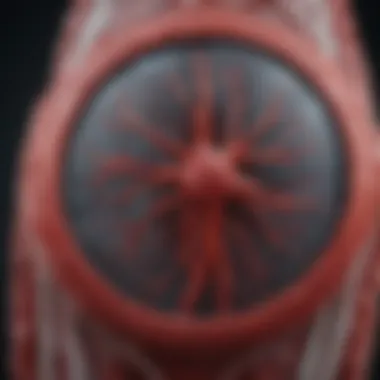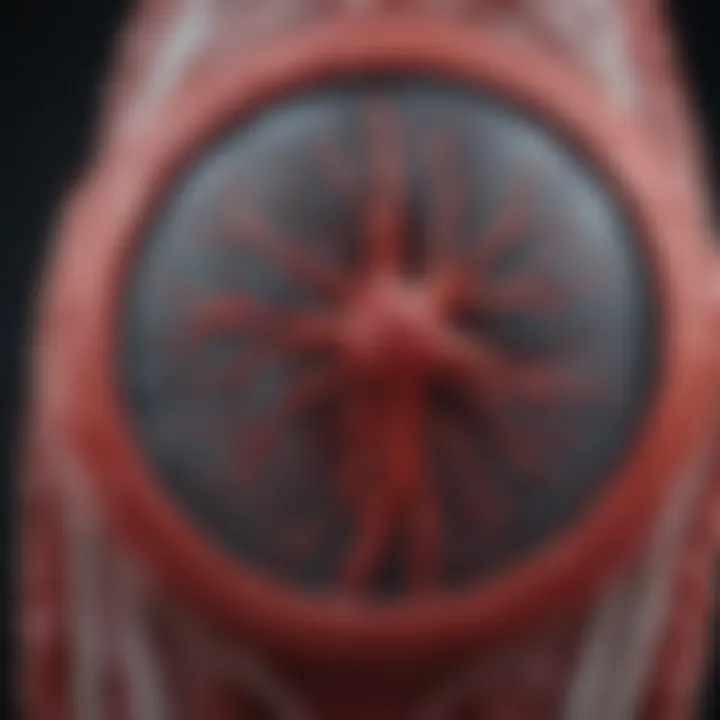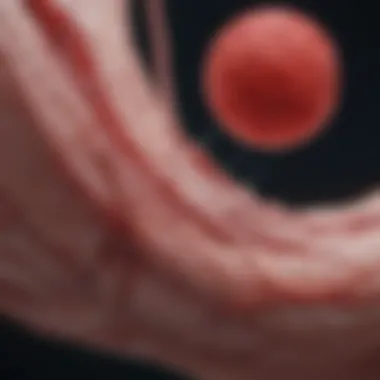Understanding Blood Vessel Scanners in Medical Practice


Intro
Blood vessel scanning technology stands at the forefront of modern medical diagnostics. Understanding its principles and applications is crucial for students, researchers, educators, and professionals alike. As the medical field moves toward personalization and precision, the role of accurate blood vessel visualization becomes increasingly significant.
This technology allows for non-invasive exploration of vascular structures. It aids in the diagnosis and management of various vascular diseases. The methodologies behind blood vessel scanners have evolved considerably, leading to advancements that enhance imaging quality and clinical effectiveness.
Through comprehensive analysis, this article aims to elucidate the complexities associated with blood vessel scanners.
Article Overview
Purpose of the Article
The primary purpose of this article is to provide a detailed examination of blood vessel scanning technology. It intends to inform readers about current techniques and their implications in clinical practices. By exploring the principles of these scanners, the article aims to illuminate their essential role in diagnosing vascular diseases—an area of immense importance in healthcare today.
Relevance to Multiple Disciplines
Blood vessel scanner technology intersects with various fields, including:
- Medicine: Understanding the anatomy and pathology of blood vessels.
- Engineering: Developing advanced imaging techniques and scanners.
- Biochemistry: Examining blood flow and cellular interactions.
- Data Science: Analyzing imaging results and improving diagnostic accuracy.
The interdisciplinary relevance underscores the importance of this technology in enhancing patient outcomes.
Research Background
Historical Context
The development of blood vessel imaging can be traced back to early methods of angiography. Traditional techniques involved invasive procedures, leading to risks for patients. Over the years, innovations such as ultrasound and magnetic resonance imaging have transformed this field. These developments allow for safer, non-invasive alternatives to visualize blood vessels.
Key Concepts and Definitions
To fully grasp the nuances of blood vessel scanning, it is important to define key terms:
- Angiography: Imaging technique used to visualize blood vessels.
- Vascular Diseases: Conditions affecting blood vessels, including stenosis and aneurysms.
- Ultrasound: An imaging method utilizing sound waves to visualize the internal structures of the body.
Expanding knowledge of these concepts establishes a foundation for subsequent discussions in the article.
Prolusion to Blood Vessel Scanners
Blood vessel scanners are essential tools in modern medical diagnostics. They play a vital role in visualizing and assessing the vascular system, offering crucial insights for healthcare professionals. The importance of this technology cannot be overstated, as it directly impacts patient outcomes by providing accurate and timely information about blood vessel conditions.
Definition and Purpose
Blood vessel scanners utilize various imaging technologies to create detailed images of the circulatory system. These images help identify issues such as blockages, aneurysms, or other vascular diseases. The purpose is to enhance diagnostic accuracy, aid in treatment planning, and monitor the effectiveness of ongoing therapies. Understanding blood vessel scanners involves recognizing their multiple uses, which include routine check-ups and urgent care scenarios.
Through advancements in technology, the effectiveness and speed of these scanners have improved significantly. Non-invasive options like ultrasounds allow for quick diagnostics without requiring surgical intervention. This is particularly significant in emergency situations where time is critical. The ability to see blood flow in real-time promotes better medical decisions.
Historical Development
The development of blood vessel scanning technology has evolved over decades. From the early days of X-rays, which provided limited insight into soft tissue structures, medical practitioners sought better imaging modalities. The introduction of Doppler ultrasound in the 1960s marked a turning point. This technology enabled practitioners to evaluate blood flow and detect abnormalities with greater precision.
Later advancements included Magnetic Resonance Imaging (MRI) and Computed Tomography (CT) angiography. These modalities provided cross-sectional images of blood vessels and surrounding tissues, leading to more comprehensive assessments. The historical trajectory of blood vessel scanners reflects a commitment to improving diagnostic techniques, ultimately enhancing patient care.
Recent innovations have further transformed this field. The integration of artificial intelligence into imaging processes allows for improved accuracy and efficiency. Future developments promise even more sophisticated tools that can refine diagnostics and lead to better patient outcomes.
Principles of Blood Vessel Scanning
Understanding the principles of blood vessel scanning is crucial in comprehending how these technologies assist in medical diagnostics. This section delves into the core technologies that facilitate effective blood vessel imaging. Key elements include detailed imaging techniques, their respective benefits, and the considerations that must be taken into account when selecting a scanning method.
Ultrasound Technology
Ultrasound technology is one of the foundational methods used in blood vessel scanning. It employs high-frequency sound waves to create images of the blood vessels. When a patient undergoes ultrasound testing, a technician applies a gel on the skin and moves a transducer over the area of interest.
The sound waves emitted by the transducer travel through the body and bounce off tissues, generating echoes. These echoes are then converted into visual images on a monitor.
Benefits of Ultrasound:
- Non-invasive: It does not require incisions or injections, which means less risk to the patient.
- Real-time imaging: This allows for immediate assessment and the ability to observe blood flow dynamically.
- Cost-effective: Ultrasound is generally less expensive than other imaging technologies, making it accessible for various healthcare settings.


However, ultrasound has limitations. The quality of images can be affected by factors such as patient body habitus and the operator's skill. It may not penetrate bone or air well, making it less effective in some anatomical regions.
Magnetic Resonance Imaging (MRI)
Magnetic Resonance Imaging (MRI) utilizes strong magnetic fields and radio waves to generate detailed images of blood vessels and surrounding tissues. MRI provides high-resolution images that can show structural abnormalities in the vascular system.
During the MRI process, the patient lies in a large magnet tube. The magnetic field aligns hydrogen atoms in the body, and radio waves create signals that are detected and translated into images.
Benefits of MRI:
- Superior resolution: MRI offers highly detailed images, allowing for better visualization of complex vascular structures.
- No ionizing radiation: Unlike CT scans, MRI does not expose patients to harmful radiation.
- Versatility: MRI can be used for various body parts and is effective for evaluating both vascular and non-vascular conditions.
Nonetheless, MRI is not without challenges. The procedure can be longer and can cause discomfort. Some patients may also have claustrophobia or cannot undergo MRI due to metal implants. Additionally, it is more expensive compared to ultrasound.
Computed Tomography (CT) Angiography
Computed Tomography Angiography (CTA) is another vital technique used in blood vessel scanning. It combines X-ray equipment with sophisticated computers to create cross-sectional images of the blood vessels. CTA often involves an injection of a contrast dye to enhance the visualization of blood vessels on the scan.
During the CTA process, the patient lies on a movable table that slides into the CT machine. As the X-ray beams rotate around the body, images are captured from different angles, which are processed by the computer to create detailed images.
Benefits of CTA:
- Speed: CTA is relatively quick, making it ideal for emergency situations where time is critical, such as in cases of suspected stroke or aneurysm.
- Comprehensive imaging: It provides detailed views of vessels, including the ability to see blockages or other abnormalities clearly.
- Wide availability: CT scanners are more commonly found in hospitals and clinics than MRI equipment, increasing accessibility.
However, CTA also has disadvantages. The major concern is exposure to ionizing radiation and the use of contrast agents, which may pose risks to certain patients, such as those with renal impairment.
In summary, the principles of blood vessel scanning cover various imaging technologies like ultrasound, MRI, and CT angiography. Each technique has its benefits and drawbacks, making the choice of method dependent on the clinical situation and the specific patient needs.
Types of Blood Vessel Scanners
The categorization of blood vessel scanners is crucial to fully understand their functionality and applications in medical practice. This section outlines two main types—non-invasive and invasive scanners, each possessing unique characteristics, applications, and considerations. Understanding these types aids medical professionals in selecting the right tool based on patient scenarios and specific diagnostic needs.
Non-Invasive Scanners
Non-invasive scanners are regarded for their ability to perform diagnostic imaging without requiring any puncture or incision on the patient's body. They allow clinicians to visualize blood vessels and assess their condition in a way that minimizes discomfort and risk to patients. Common modalities in this category include Doppler Ultrasound, Magnetic Resonance Angiography, and Computed Tomography Angiography.
- Doppler Ultrasound: This technique utilizes sound waves to measure the flow of blood through the vessels. It is particularly effective for diagnosing conditions such as deep vein thrombosis and carotid artery stenosis.
- Magnetic Resonance Angiography (MRA): MRA provides detailed images of blood vessels using magnetic fields and radio waves. It is invaluable for imaging complex vascular structures or abnormalities within the bloodstream.
- Computed Tomography Angiography (CTA): CTA combines traditional CT imaging with contrast material to offer a detailed view of both blood vessels and surrounding structures. It is often used in emergency settings to assess vascular trauma.
These scanners are significant in routine clinical practice. They enable fast diagnosis, reduce the need for patient sedation, and eliminate many complications associated with invasive procedures. The absence of incisions also lowers infection risks, making them a preferable option in many cases.
Invasive Scanners
Invasive scanners contrast sharply with non-invasive modalities, as they involve entering the body to obtain images. These methods typically require catheterization, where a thin tube is inserted into a blood vessel. Angiography is an illustrative example of this technique.
- Angiography: It involves injecting a contrast dye through a catheter into the blood vessels, followed by acquiring images using X-ray technology. This method provides clear and detailed images of blood flow and obstruction. It allows interventional procedures to be performed concurrently, such as stenting or balloon angioplasty.
The importance of invasive scanners lies in their ability to produce more definitive results in complex cases. When non-invasive methods do not yield sufficient information, invasive scanners provide a solution. However, they carry higher risks including bleeding, infection, or allergic reactions to the contrast dye. Proper patient selection is critical to minimize potential complications.
In summary, both non-invasive and invasive blood vessel scanners have distinct roles in vascular imaging. By understanding each type's benefits and limitations, healthcare providers can make informed decisions, ultimately leading to enhanced patient care and outcomes.
Applications in Medical Diagnostics
The applications of blood vessel scanners in medical diagnostics are pivotal. These technologies play a significant role in the detection and management of various vascular diseases. Their ability to provide detailed images enables healthcare professionals to make informed decisions, resulting in better patient outcomes. Understanding how these applications work helps both practitioners and patients appreciate the sophistication and necessity of blood vessel imaging.
Detection of Vascular Diseases
Detection of vascular diseases is a primary use of blood vessel scanners. Vascular diseases can range from arterial blockages to complex aneurysms. The technology allows for non-invasive investigations, reducing the need for exploratory surgeries. Techniques like Doppler ultrasound can assess blood flow in real-time, identifying any irregularities. Such advancements enable early diagnosis and timely treatment, which can significantly alter patient prognosis. Factors like age, family history, and lifestyle choices contribute to an individual's risk, making this detection critical for targeted interventions.
Preoperative Planning
Preoperative planning is another significant application. Before any procedure, understanding the patient’s vascular structure is crucial. Blood vessel scanners provide a roadmap for surgeons, helping to visualize the anatomy involved in the operation. This visualization enables the identification of potential complications or variations in vascular anatomy that may arise during surgery. Additionally, this intricate mapping can enhance the precision of procedures such as bypass surgery or tumor removals. Surgeons can plan their approaches with more confidence, improving overall surgical efficiency.
Monitoring Treatment Progress
Monitoring treatment progress is essential in managing vascular conditions. After initiating therapy, whether surgical or pharmaceutical, tracking the effectiveness of the treatment is necessary. Blood vessel scanners can measure changes in blood flow and vessel integrity over time. For example, in the case of endovenous laser therapy for varicose veins, post-treatment scanning can show immediate results. Ongoing assessments allow healthcare providers to adjust treatment plans based on real-time data, ensuring optimal patient care.
"A proactive approach in monitoring treatment outcomes can lead to early detection of issues, enabling timely interventions that could be lifesaving."


"A proactive approach in monitoring treatment outcomes can lead to early detection of issues, enabling timely interventions that could be lifesaving."
In summary, applications in medical diagnostics showcase the importance of blood vessel scanners in modern healthcare. Detection of vascular diseases, meticulous preoperative planning, and continued monitoring of treatment progress represent critical areas where these technologies are not only helpful but essential for effective patient management.
Technological Advancements
Technological advancements in blood vessel scanning play a critical role in enhancing the capabilities of medical diagnostics. As technology advances, blood vessel scanners have evolved significantly, leading to improved accuracy and efficiency in the detection of vascular diseases. These developments not only refine imaging techniques but also increase the overall effectiveness of medical education and patient care.
Integration of Artificial Intelligence
The integration of artificial intelligence (AI) into blood vessel scanning presents a revolutionary shift in the field of medical imaging. AI algorithms are now employed to analyze images quickly with a high precision, offering an efficient solution to traditional manual interpretation methods. This technology systematically identifies patterns that may elude the human eye, reducing diagnostic errors.
AI systems can help prioritize urgent cases, enabling healthcare professionals to allocate resources more effectively. This capability is particularly useful in emergency situations where rapid decision-making is essential. Furthermore, training these algorithms on large datasets enhances their predictive performance, making them invaluable tools for radiologists and vascular specialists. The collaboration between AI and human expertise represents a synergistic approach to imaging, whereby technology augments human capability rather than replacing it.
Real-Time Imaging Techniques
Real-time imaging techniques have emerged as a prominent advancement in blood vessel scanning. These methods allow for immediate visualization of vascular structures during procedures, which significantly improves the quality of interventions. Techniques such as ultrasound imaging exploit sound waves to provide continuous feedback on blood flow dynamics. This real-time interaction can enhance the accuracy of needle placements during biopsies or guide catheter insertions in vascular interventions.
Real-time imaging also offers dynamic assessments of blood flow, helping to identify blockages or abnormalities as they develop. Such information is crucial for tailoring immediate treatment strategies for patients in critical conditions. Moreover, integrating these techniques with advanced imaging systems allows for fusion imaging, bringing together information from multiple modalities like MRI and CT to provide comprehensive views of the vascular system.
"The evolution of imaging technologies is reshaping the approach to vascular diagnostics and interventions, ultimately leading to better patient outcomes."
"The evolution of imaging technologies is reshaping the approach to vascular diagnostics and interventions, ultimately leading to better patient outcomes."
Challenges in Blood Vessel Detection
Blood vessel detection presents significant challenges, impacting accuracy and effectiveness in diagnosing vascular diseases. As technology evolves, it is essential to address these limitations and patient-specific factors that may hinder optimal imaging results. Understanding these elements is crucial for improving interventions and advancing the science of vascular diagnostics.
Technical Limitations
Technical limitations often arise from the inherent characteristics of the scanning modalities. For instance, ultrasound imaging can be affected by the operator's skill and experience. High-resolution images depend on the quality of equipment and the technician's ability to maneuver the transducer correctly. Furthermore, conventional MRI systems may present difficulties in distinguishing small vessels or those surrounded by complex tissues. Artifacts can also distort images, leading to misinterpretations.
The technology used may not provide adequate contrast to delineate the vessels from surrounding structures. For example, in cases of calcified vessels, the presence of calcium can impede accurate visualization. Additionally, the need for contrast materials in some imaging techniques introduces risks of allergies and kidney complications, thus making certain patients ineligible for these procedures. These technical affects, while not strictly insurmountable, underscore the need for ongoing innovation.
Patient-Specific Factors
Each patient presents unique challenges in blood vessel detection, adding layers of complexity to imaging. Factors such as obesity or excessive muscle mass can reduce image quality in ultrasound or CT scans. The anatomy of blood vessels may also vary significantly among individuals. Any deviation from typical anatomical structures can complicate the accuracy of detection.
Moreover, comorbid conditions can influence outcomes. For instance, patients with diabetes may have increased vascular stiffness, making assessment more difficult. Age is another critical factor; older adults often exhibit vascular calcification, complicating diagnostic clarity. Understanding these patient-specific factors is essential in tailoring imaging approaches and improving diagnostic yield.
"The effectiveness of imaging techniques is not solely dependent on technology but also on individual patient characteristics that must be considered."
"The effectiveness of imaging techniques is not solely dependent on technology but also on individual patient characteristics that must be considered."
Addressing the challenges in blood vessel detection requires a thorough understanding of both technical limitations and patient-specific factors. Keeping these elements in focus will drive future advancements, leading to more accurate diagnostics and better patient care.
Research Trends
In the evolving landscape of blood vessel scanning, research trends play a vital role in enhancing our understanding and application of these technologies. These trends not only reflect advancements in imaging modalities but also underscore the ongoing quest to optimize diagnostic capabilities in clinical practice. As vascular diseases continue to confront healthcare systems worldwide, focused research efforts are crucial in addressing gaps in knowledge and improving patient outcomes.
Innovative Imaging Modalities
Innovative imaging modalities represent a significant frontier in blood vessel scanning. Researchers are actively exploring methods that can capture more detailed and accurate representations of vascular structures. Techniques such as optical coherence tomography (OCT) and photoacoustic imaging are gaining traction. These modalities offer high-resolution images, which are invaluable for the early detection and assessment of vascular diseases.
A notable benefit of these innovations is their ability to provide real-time imaging. This feature can greatly enhance the speed and effectiveness of diagnoses, allowing for quicker treatment decisions. Moreover, the integration of multidimensional imaging helps in assessing the functionality and flow characteristics of blood vessels. This multifaceted approach to visualization is crucial for comprehensive assessments, particularly in complex cases where traditional imaging may fall short.
Comparative Studies of Scanning Technologies
Comparative studies of scanning technologies are essential for determining the advantages and limitations of each method. By systematically evaluating ultrasound, MRI, CT angiography, and emerging technologies, researchers aim to establish benchmarks for accuracy, sensitivity, and specificity in vascular imaging. These studies often highlight how different technologies may yield varying results based on specific clinical scenarios.
For instance, a recent study indicated that while CT angiography excels in depicting large vessel pathologies, ultrasound may offer superior insights into superficial vascular anomalies. Understanding these distinctions allows practitioners to choose the most suitable imaging modality based on individual patient needs.
Moreover, these comparisons inform best practices for combining technologies, potentially leading to enhanced diagnostic workflows. As these findings penetrate clinical guidelines, patient care can become more tailored, promoting better health outcomes.
"The value of research lies not just in findings, but in their translation to improved treatments and patient care."
"The value of research lies not just in findings, but in their translation to improved treatments and patient care."


In summary, the exploration of research trends, particularly in innovative imaging modalities and comparative studies, lays the groundwork for significant advancement in blood vessel scanning technology. The focus on precision, faster diagnosis, and patient-centered approaches will likely shape future practices in vascular health.
Impact on Patient Care
The relevance of blood vessel scanners in the medical field cannot be overstated. Their evolution has dramatically changed how vascular diseases are diagnosed and managed. Accurate imaging of blood vessels is essential for effective treatment plans and ongoing patient monitoring. This section focuses on how blood vessel scanners enhance patient care by improving diagnostic accuracy and patient outcomes.
Enhanced Diagnostic Accuracy
Blood vessel scanners play a pivotal role in diagnostic imaging. These devices provide detailed visualization of the vascular system, crucial for identifying conditions like atherosclerosis, aneurysms, and deep vein thrombosis. With technologies such as ultrasound and MRI, medical practitioners can observe blood flow and vessel structure in real-time, making it easier to detect anomalies.
Key benefits of enhanced diagnostic accuracy include:
- Early detection of diseases: Recognizing conditions at an early stage increases the likelihood of effective management.
- Reduced misdiagnosis: Detailed imaging reduces the chances of errors, facilitating better treatment approaches.
- Informed decision-making: Accurate diagnosis supports clinicians in tailoring specific treatment plans according to individual patient needs.
Advanced imaging techniques result in more precise data, which is crucial for guiding treatment strategies effectively.
Advanced imaging techniques result in more precise data, which is crucial for guiding treatment strategies effectively.
Patient Outcome Improvement
The impact of blood vessel scanners extends beyond diagnosis; they also improve patient outcomes significantly. By providing an avenue for accurate monitoring and tailored treatments, these devices directly influence patient recovery and well-being.
Factors contributing to patient outcome improvements include:
- Better treatment plans: With accurate imaging, healthcare providers can design intervention strategies that align with the specific conditions of each patient.
- Ongoing monitoring: Continuous imaging helps track treatment efficacy, allowing for timely adjustments based on patient progress.
- Reduced complications: Enhanced diagnostics lead to timely interventions, minimizing the risk of serious complications associated with vascular diseases.
In summary, blood vessel scanners contribute a level of precision and enhanced capability to the diagnostic process. They not only ensure accurate diagnoses but also foster improvements in treatment outcomes, thus playing an essential role in patient care in modern medicine.
Future Directions in Blood Vessel Scanning
The future directions in blood vessel scanning technology are increasingly vital in modern healthcare. Understanding these advancements provides clarity on how medical diagnostics are evolving. One significant focus is the potential for personalized medicine. This concept tailors medical treatments to individual patient characteristics. Blood vessel scanners are essential in identifying the unique vascular structures of patients, offering insights that can lead to more effective treatment plans.
Potential for Personalized Medicine
Personalized medicine is changing how healthcare professionals approach treatment. By leveraging blood vessel scanners, doctors can observe specific vascular characteristics that differ from patient to patient. This approach allows for tailored interventions that can enhance patient outcomes.
- Benefits include:
- More precise diagnosis by understanding individual vascular anatomy.
- Customized treatment plans that consider the unique challenges present in each vascular case.
- Improved monitoring of treatment effectiveness throughout the course of care.
Investing in these technologies ensures that patients receive the right treatment at the right time. This aspect of personalized medicine is shifting paradigms in vascular health management.
Emerging Technologies on the Horizon
As the field of blood vessel scanning develops, new technologies continue to emerge. These advancements promise to enhance imaging capabilities and improve diagnostic accuracy. Some key innovations on the horizon include:
- Portable ultrasound devices:
These devices are becoming more user-friendly, allowing for quick examinations outside traditional settings, improving accessibility. - High-resolution imaging techniques:
Enhanced imaging can reveal finer details of blood vessels, aiding in earlier detection of vascular diseases. - Integration with artificial intelligence:
AI algorithms can analyze imaging data more quickly and accurately, helping doctors make faster decisions.
These emerging technologies are expected to significantly impact how blood vessel conditions are diagnosed and treated. As they develop, the role of blood vessel scanners will evolve, creating more efficient and effective patient care pathways.
"Technological innovation is key to enhancing the effectiveness of medical diagnostics and improving patient care."
"Technological innovation is key to enhancing the effectiveness of medical diagnostics and improving patient care."
Epilogue
The conclusion serves as a pivotal part of this exploration into blood vessel scanning technology. It consolidates the findings discussed in earlier sections, providing a clear overview of the significant advancements, applications, and future directions in this field. Understanding these elements is crucial for students, researchers, and medical professionals alike, as it emphasizes the growing role of technology in improving patient care and diagnostic accuracy.
Summary of Key Findings
This article highlighted several important aspects of blood vessel scanners:
- Technological Principles: An understanding of ultrasound, MRI, and CT angiography underpins the operation of various scanning modalities.
- Types of Scanners: The distinction between non-invasive and invasive scanners is vital for appropriate clinical application.
- Clinical Applications: The technological systems in place facilitate the detection of vascular diseases and aid in preoperative planning and monitoring treatment.
- Research and Innovation: Recent advancements indicate a trend towards integrating artificial intelligence and real-time imaging, showcasing the scope for ongoing improvements.
These findings reinforce the importance of blood vessel scanners in modern healthcare. The capacity for precise imaging continues to enhance diagnostic practices significantly.
Final Thoughts on Blood Vessel Scanners
Blood vessel scanners represent a crucial aspect of contemporary medicine. Their evolution reflects the blend of engineering and healthcare, delivering solutions for conditions that can often be difficult to diagnose. As technology progresses, the potential for personalized medicine grows. These scanners provide invaluable information that tailors treatment to the patient's unique vascular architecture.
Blood vessel scanners are reshaping diagnostic landscapes, making it possible to visualize and treat diseases with unprecedented precision.
Blood vessel scanners are reshaping diagnostic landscapes, making it possible to visualize and treat diseases with unprecedented precision.



